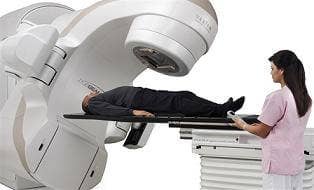Radiation Robots Fry Cancer Cells With Ultra-High Precision (video)

Share
Radiation therapy may be a great way to kill a tumor, but when doctors zap cancer cells they end up hitting healthy ones too. Thankfully, the last decade has given us super-accurate radiation-blasting robotic systems that can target and fire with millimeter precision. Snipe the cancer, leave the healthy cells standing. For years Accuray (NASDAQ:ARAY) and TomoTherapy (NASDAQ:TOMO) have been the big names in the field, but last month med-tech giant Varian (NYSE:VAR) released their own automated radiation system, the TrueBeam, with even better accuracy than the others. Join us as we take a look at these life-saving machines that are helping patients recover faster and safer with robotics.
While each of these systems work slightly differently, they all provide the same basic service: killing cancer cells in tumors using high energy radiation (x-rays). In years past, this work was done using linear accelerators and required tedious (and nerve wracking) alignments by a technician. Inevitably, such machines kill healthy cells along with cancerous ones.
The new breed of radiation robots is lowering the rate of dead healthy cells. They all have one large advantage over traditional radiation therapy methods: accuracy. Accuray's automated radiation machine, Cyberknife, pivots and tilts around you to find the best access point to irradiate a tumor, and can hit a target within a millimeter or so. TomoTherapy uses a shuttering system on their machine to achieve similar precision. Varian's TrueBeam machine couples with their RapidArc software to provide dynamic adjustments with only 10 ms delay, giving them sub-millimeter precision. In each case, doctors can program the desired target area in the body and let the machine pivot and adjust to hit the tumor on its own. They are used to treat a wide variety of cancers from brain to prostate.
I don't want to display too much preference among these three systems, so I'll try to let each company speak for itself.
TomoTherapy:
I love the restraining mask at 1:32 in the following video from Accuray...sometimes medicine is really trippy:
Be Part of the Future
Sign up to receive top stories about groundbreaking technologies and visionary thinkers from SingularityHub.


Varian only released their TrueBeam/RapidArc system in April, with its first use seen in Zurich. As such, their demo is only a simulation without a narrative. Still, I think you can get the idea of what's happening:
https://multivu.prnewswire.com/mnr/mnr_lib/201002/players/player-single.swf
Cancer has a huge social and economic impact on the US and the rest of the industrialized world. According to the National Cancer Institute's latest update, more than $100 billion was spent on cancer treatments in 2006 in the US (the most recent year for which information is available). Another $130 billion was lost due to cancer related deaths. Preventative medicine is set to undergo a revolution based on increased health monitoring and medical data, which will hopefully lead to a dramatic reduction in cancer rates. Yet we will still need radiation therapies and surgeries, and we will want them to be as accurate, fast, and safe as possible.
It's clear that advanced radiation robots could really work to bring down cancer mortality. With improved precision, they are able to eliminate more cancerous cells in each treatment, leading to lower radiation exposure for each patient. This leads to better success in eliminating tumors and reduces the incidence of radiation therapy related sickness. Fewer deaths and less time in the hospital - these are things we can all be happy about.
Just as importantly though, these tumor sniping systems could work to bring down healthcare costs as well. While they are expensive (each of these systems cost between $2.5 and $4.5 million) hospitals are able to treat patients much faster with these automated systems. Accuray and TomoTherapy will argue over who's quicker, but both seem to have average session lengths in the 30-90 minute range. Data from Varian is still coming in, but they're looking at less than a 60 minutes session. Most of this time involves setup and patient interactions, not actual treatment (which can take less than 120 seconds). Varian has specifically targeted the time lost to setup by making TrueBeam's controls simpler with fewer buttons. No matter which system a hospital uses, however, they are looking at increased throughput and fewer complications. These are things that hospitals administrations can be happy about.
This is a developing field, with billions of dollars at stake and customers (hospitals) willing to shop between systems before making their investment. Hopefully the competition between these three companies will help drive down prices and ramp up innovation. Varian's TrueBeam system, the newest of three, already displays better precision, faster adjustments to patient movement, and a better integration of the imaging/targeting mechanics. Cyberknife's gone through several improvements in the last decade, as have TomoTherapy's machines. In the years ahead, we may see the precision of the radiation robots continue to improve, allowing doctors to target smaller and smaller groups of cells, destroying tumors and nothing but tumors. So three cheers for the competition between TomoTherapy, Accuray, and Varian. No matter who loses, it looks like the patients are going to win.
[image credit: Varian]
[video credits: Accuray, Tomo Therapy, Varian]
[source: Varian, Accuray, TomoTherapy, National Cancer Institute]
Related Articles

These Robots Are the Size of Single Cells and Cost Just a Penny Apiece

In Wild Experiment, Surgeon Uses Robot to Remove Blood Clot in Brain 4,000 Miles Away

A Squishy New Robotic ‘Eye’ Automatically Focuses Like Our Own
What we’re reading
